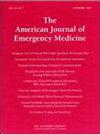比较急诊科医生和高级护理提供者使用阿片类药物治疗急性胸痛
IF 2.2
3区 医学
Q1 EMERGENCY MEDICINE
引用次数: 0
摘要
背景:急性胸痛是一种常见且高风险的急诊科(ED)症状,通常与急性冠脉综合征(ACS)相关。阿片类药物,如吗啡和芬太尼,在症状持续时使用,尽管使用硝酸盐,但很少有人知道高级护理提供者(acp)和医生之间的处方是否不同。目的比较学术ED的acp和医生对ACS相关胸痛的静脉注射(IV)吗啡和芬太尼处方模式。方法我们对2021年1月至2024年1月在学术ED就诊的成年ACS患者进行回顾性研究。主要结局为静脉注射吗啡;次要终点是静脉注射芬太尼。多变量logistic回归校正了人口统计学、临床因素和使用阿片类药物前的硝酸甘油。采用Firth惩罚逻辑回归进行敏感性分析。结果2055例患者中,接受acp治疗的154例(7.5%),内科医生治疗的1901例(92.5%)。两组间吗啡的使用相似(42.2% vs 42.8%, p = 0.93),而芬太尼在acp患者中的使用较少(5.8% vs 11.6%, p = 0.03)。在调整后的模型中,ACP与医师状态与吗啡(OR 0.78, 95% CI 0.49-1.24)或芬太尼使用(OR 1.10, 95% CI 0.50-2.49)无显著相关。在阿片类药物之前使用硝酸甘油与减少阿片类药物给药密切相关。敏感性分析证实了这些发现。结论调整后ACPs与医师对ACPs相关胸痛的阿片类药物处方无显著差异。处方决定更多地由患者因素和治疗顺序驱动,支持acp和医生在ED ACS疼痛管理中的可比作用。本文章由计算机程序翻译,如有差异,请以英文原文为准。
Comparing physician and advanced care provider use of opioids for treatment of acute chest pain in the emergency department
Background
Acute chest pain is a common and high-stakes emergency department (ED) presentation, frequently associated with acute coronary syndrome (ACS). Opioids such as morphine and fentanyl are used when symptoms persist despite nitrates, but little is known about whether prescribing differs between advanced care providers (ACPs) and physicians.
Objective
To compare intravenous (IV) morphine and fentanyl prescribing patterns for ACS-related chest pain between ACPs and physicians in an academic ED.
Methods
We performed a retrospective study of adult patients with ACS presenting to an academic ED from January 2021 to January 2024. The primary outcome was IV morphine administration; the secondary outcome was IV fentanyl administration. Multivariable logistic regression adjusted for demographics, clinical factors, and nitroglycerin administration prior to opioid. Firth's penalized logistic regression was conducted as sensitivity analysis.
Results
Among 2055 patients, 154 (7.5 %) were treated by ACPs and 1901 (92.5 %) by physicians. Morphine use was similar between groups (42.2 % vs 42.8 %, p = 0.93), while fentanyl was less common with ACPs (5.8 % vs 11.6 %, p = 0.03). In adjusted models, ACP vs Physician status was not significantly associated with morphine (OR 0.78, 95 % CI 0.49–1.24) or fentanyl use (OR 1.10, 95 % CI 0.50–2.49). Nitroglycerin prior to opioid was strongly associated with reduced opioid administration. Sensitivity analyses confirmed these findings.
Conclusion
Opioid prescribing for ACS-related chest pain did not differ significantly between ACPs and physicians after adjustment. Prescribing decisions were driven more by patient factors and treatment sequencing, supporting comparable roles for ACPs and physicians in ED ACS pain management.
求助全文
通过发布文献求助,成功后即可免费获取论文全文。
去求助
来源期刊
CiteScore
6.00
自引率
5.60%
发文量
730
审稿时长
42 days
期刊介绍:
A distinctive blend of practicality and scholarliness makes the American Journal of Emergency Medicine a key source for information on emergency medical care. Covering all activities concerned with emergency medicine, it is the journal to turn to for information to help increase the ability to understand, recognize and treat emergency conditions. Issues contain clinical articles, case reports, review articles, editorials, international notes, book reviews and more.

 求助内容:
求助内容: 应助结果提醒方式:
应助结果提醒方式:


